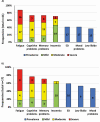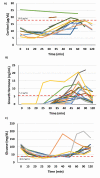Experience of a Pituitary Clinic for US Military Veterans With Traumatic Brain Injury
- PMID: 33655093
- PMCID: PMC7903186
- DOI: 10.1210/jendso/bvab005
Experience of a Pituitary Clinic for US Military Veterans With Traumatic Brain Injury
Abstract
Context: Traumatic brain injury (TBI) is considered the "signature" injury of veterans returning from wartime conflicts in Iraq and Afghanistan. While moderate/severe TBI is associated with pituitary dysfunction, this association has not been well established in the military setting and in mild TBI (mTBI). Screening for pituitary dysfunction resulting from TBI in veteran populations is inconsistent across Veterans Affairs (VA) institutions, and such dysfunction often goes unrecognized and untreated.
Objective: This work aims to report the experience of a pituitary clinic in screening for and diagnosis of pituitary dysfunction.
Methods: A retrospective analysis was conducted in a US tertiary care center of veterans referred to the VA Puget Sound Healthcare System pituitary clinic with a history of TBI at least 12 months prior. Main outcome measures included demographics, medical history, symptom burden, baseline hormonal evaluation, brain imaging, and provocative testing for adrenal insufficiency (AI) and adult-onset growth hormone deficiency (AGHD).
Results: Fatigue, cognitive/memory problems, insomnia, and posttraumatic stress disorder were reported in at least two-thirds of the 58 patients evaluated. Twenty-two (37.9%) were diagnosed with at least one pituitary hormone deficiency, including 13 (22.4%) AI, 12 (20.7%) AGHD, 2 (3.4%) secondary hypogonadism, and 5 (8.6%) hyperprolactinemia diagnoses; there were no cases of thyrotropin deficiency.
Conclusion: A high prevalence of chronic AI and AGHD was observed among veterans with TBI. Prospective, larger studies are needed to confirm these results and determine the effects of hormone replacement on long-term outcomes in this setting.
Keywords: GH; TBI; adrenal insufficiency; growth hormone deficiency; head trauma; hypopituitarism.
Published by Oxford University Press on behalf of the Endocrine Society 2021.
Figures






Similar articles
-
Metabolic and quality of life effects of growth hormone replacement in patients with TBI and AGHD: A pilot study.Growth Horm IGF Res. 2023 Aug;71:101544. doi: 10.1016/j.ghir.2023.101544. Epub 2023 Jun 1. Growth Horm IGF Res. 2023. PMID: 37295336 Free PMC article.
-
High prevalence of chronic pituitary and target-organ hormone abnormalities after blast-related mild traumatic brain injury.Front Neurol. 2012 Feb 7;3:11. doi: 10.3389/fneur.2012.00011. eCollection 2012. Front Neurol. 2012. PMID: 22347210 Free PMC article.
-
Association between mild traumatic brain injury and mental health problems and self-reported cognitive dysfunction in Iraq and Afghanistan Veterans.J Rehabil Res Dev. 2016;53(2):185-98. doi: 10.1682/JRRD.2014.12.0301. J Rehabil Res Dev. 2016. PMID: 27148692
-
GH and Pituitary Hormone Alterations After Traumatic Brain Injury.Prog Mol Biol Transl Sci. 2016;138:167-91. doi: 10.1016/bs.pmbts.2015.10.010. Epub 2015 Nov 4. Prog Mol Biol Transl Sci. 2016. PMID: 26940391 Review.
-
Anterior hypopituitarism following traumatic brain injury.Brain Inj. 2005 May;19(5):349-58. doi: 10.1080/02699050400004807. Brain Inj. 2005. PMID: 16094782 Review.
Cited by
-
Acute and chronic hypopituitarism following traumatic brain injury: a systematic review and meta-analysis.Neurosurg Rev. 2024 Nov 11;47(1):841. doi: 10.1007/s10143-024-03088-3. Neurosurg Rev. 2024. PMID: 39527353 Free PMC article.
-
IGF-1 as a Biomarker for Symptom Severity in Adult Traumatic Brain Injury: Evidence from an Observational Study.Neurotrauma Rep. 2025 Apr 21;6(1):345-354. doi: 10.1089/neur.2025.0009. eCollection 2025. Neurotrauma Rep. 2025. PMID: 40697802 Free PMC article.
-
Growth hormone and IGF-1 actions in the brain and neuropsychiatric diseases.Physiology (Bethesda). 2025 Jul 7:10.1152/physiol.00009.2025. doi: 10.1152/physiol.00009.2025. Online ahead of print. Physiology (Bethesda). 2025. PMID: 40623083 Free PMC article. Review.
-
Neuroendocrine Disruptions Following Head Injury.Curr Neurol Neurosci Rep. 2023 May;23(5):213-224. doi: 10.1007/s11910-023-01263-5. Epub 2023 May 6. Curr Neurol Neurosci Rep. 2023. PMID: 37148402 Free PMC article. Review.
-
Metabolic and quality of life effects of growth hormone replacement in patients with TBI and AGHD: A pilot study.Growth Horm IGF Res. 2023 Aug;71:101544. doi: 10.1016/j.ghir.2023.101544. Epub 2023 Jun 1. Growth Horm IGF Res. 2023. PMID: 37295336 Free PMC article.
References
-
- 649013 DI. Comprehensive policy on traumatic brain injury-related neurocognitive assessments by the military services. In: Defense, ed. Washington, DC: Department of Defense; 2015.
-
- Defense and Veterans Brain Injury Center. DoD worldwide numbers for traumatic brain injury. https://health.mil/About-MHS/OASDHA/Defense-Health-Agency/Research-and-D.... Accessed December 20, 2020.
-
- Summerall EL. Traumatic brain injury and PTSD: focus on veterans. 2018; https://www.ptsd.va.gov/professional/treat/cooccurring/tbi_ptsd_vets.asp.... Accessed December 20, 2020.
-
- Hoge CW, McGurk D, Thomas JL, Cox AL, Engel CC, Castro CA. Mild traumatic brain injury in U.S. soldiers returning from Iraq. N Engl J Med. 2008;358(5):453-463. - PubMed
-
- Carroll PV, Christ ER, Bengtsson BA, et al. Growth hormone deficiency in adulthood and the effects of growth hormone replacement: a review. Growth Hormone Research Society Scientific Committee. J Clin Endocrinol Metab. 1998;83(2):382-395. - PubMed
Grants and funding
LinkOut - more resources
Full Text Sources
Other Literature Sources
